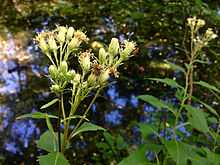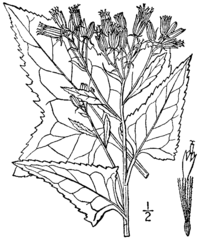Hasteola suaveolens
| Hasteola suaveolens | |
|---|---|
 | |
| Scientific classification | |
| Kingdom: | Plantae |
| Family: | Asteraceae |
| Genus: | Hasteola |
| Species: | H. suaveolens |
| Binomial name | |
| Hasteola suaveolens (L.) Pojark | |
| Synonyms | |
|
Cacalia suaveolens L. | |
Hasteola suaveolens (known by the common name Sweet Scented Indian Plantain), is a perennial forb native to the eastern United States,[2] which produces cream colored composite flowers in late summer or early fall.
Description

Hasteola suaveolens is glabrous throughout. The erect stem is 90 to 150 centimeters tall and unbranched until the inflorescence. The spearhead shaped leaves are 10 to 25 centimeters long and 5 to 15 centimeters wide with serrated edges. The inflorescence is one or several roughly flat topped clusters of several to numerous flowerheads consisting entirely of disk florets, with no ray florets. The fruit are cypselae with a pappus of white bristles.[3][4][5]
Distribution and habitat
Hasteola suaveolens is widely distributed in the eastern United States, although local distribution may be spotty. It has been recorded in Connecticut, Washington, D.C., Georgia, Iowa, Illinois, Indiana, Kentucky, Massachusetts, Maryland, Maine, Minnesota, Missouri, North Carolina, New Jersey, New York, Ohio, Pennsylvania, Rhode Island, Tennessee, Virginia, Wisconsin, and West Virginia. Hasteola suaveolens is listed as an endangered species in the states of Connecticut, Maryland, Minnesota and New York, it is listed as threatened in Iowa and Tennessee, and it is listed as historical in Rhode Island, meaning that it is presumed extirpated.[2] Hasteola suaveolens is now less common or absent in the northern part of its range.[4] There may be only one population left of this species in all of New England.[5] In Virginia, it grows in habitats such as floodplain forests and riverbanks, along the Potomac, Shenandoah, and New rivers.[6] The presence of this species is dependent on appropriate habitat, and it may be eliminated from an area by development, changes in land use, or competition with invasive species.
Taxonomy
There is currently some taxonomic controversy over the genera placement of this species with regard to its phylogenetic relationships. It has been renamed several times in the past two decades. It may be renamed Senecio suaveolens, or something else.[6]
References
- ↑ "Hasteola suaveolens (L.) Pojark.. - The Plant List". Retrieved February 12, 2014. The Plant List (2013). Version 1.1. Published on the Internet; http://www.theplantlist.org/
- ↑ 2.0 2.1 "Plants Profile for Hasteola suaveolens (false Indian plantain)". Retrieved February 12, 2014. USDA, NRCS. 2014. The PLANTS Database (http://plants.usda.gov). National Plant Data Team, Greensboro, NC 27401-4901 USA.
- ↑ Britton, Nathaniel Lord & Brown, Addison (1913). An Illustrated Flora of the Northern United States, Canada and the British Possessions: From Newfoundland to the Parallel of the Southern Boundary of Virginia, and from the Atlantic Ocean Westward to the 102d Meridian, Volume 3., p. 538. Charles Scribner's Sons, New York.
- ↑ 4.0 4.1 "Hasteola suaveolens in Flora of North America @ efloras.org". Retrieved February 12, 2014. 'eFloras (2008). Published on the Internet (http://www.efloras.org). Missouri Botanical Garden, St. Louis, MO & Harvard University Herbaria, Cambridge, MA.
- ↑ 5.0 5.1 "Senecio suaveolens (false Indian-plantain): Go Botany". Retrieved February 12, 2014. Copyright © 2011-2013 New England Wild Flower Society (http://www.newenglandwild.org)
- ↑ 6.0 6.1 "Digital Atlas of the Virginia Flora | Senecio suaveolens (L.) Ell.". Retrieved February 12, 2014. Virginia Botanical Associates. (2014). Digital Atlas of the Virginia Flora (http://www.vaplantatlas.org). c/o Virginia Botanical Associates, Blacksburg.